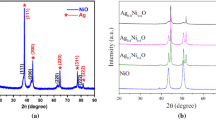Abstract
Laser sintering process is a promising technique which can sinter an electrode pattern selectively without mask. In this study, metal oxide nanoparticle with several solvents and various molar ratio of polyvinylpyrrolidone (PVP) is prepared to optimize a fabrication of a copper electrode pattern. As a result, the solvent with exothermic heat flow and low absorption cross-section shows better pattern shape and higher conductivity in selective laser sintering. Additionally, PVP, a reductant, affects to the quality of electrode, too. High molar ratio and large amount of PVP make the laser sintering process window broad and the specific resistivity low.







Similar content being viewed by others
References
A.E. Cohen, R.R. Kunz, Large-area interdigitated array microelectrodes for electrochemical sensing. Sens. Actuators B 62, 23–29 (2000)
A. Tsigara, A. Benkhial, S. Warren, F. Akkari, J. Wright, F. Frehill, E. Dempsey, Metal microelectrode nanostructuring using nanosphere lithography and photolithography with optimization of the fabrication process. Thin Solid Film 537, 269–274 (2013)
W.S. Beh, I.T. Kim, D. Qin, Y. Xia, G.M. Whitesides, Formation of patterned mircostuctures of conducting polymers by soft lithography, and application in microelectronic device fabrication. Adv. Mater. 11, 1038–1041 (1999)
N.R. Bieri, J. Chung, S.E. Haferl, D. Poulikakos, C.P. Grigoropoulos, Microstructuring by printing and laser curing of nanoparticle solutions. Appl. Phys. Lett. 82, 3529–3531 (2003)
M. Aminuzzaman, A. Watanabe, T. Miyashita, Direct writing of conductive silver micropatterns on flexible polyimide film by laser-induced pyrolysis of silver nanoparticle-dispersed film. J. Nanopart Res. 12, 931–938 (2010)
J. Chung, N.R. Bieri, S. Ko, C.P. Grigoropoulos, D. Poulikakos, In-tandem deposition and sintering of printed gold nanoparticle inks induced by continuous Gaussian laser irradiation. Appl. Phys. A 79, 1259–1261 (2004)
N.R. Bieri, J. Chung, D. Poulikakos, C.P. Grigoropoulos, Manufacturing of nanoscale thickness gold lines by laser curing of a discretely deposited nanoparticle suspension. Superlattices Microstruct. 35, 437–444 (2004)
N.R. Bieri, J. Chung, D. Poulikakos, C.P. Grigoropoulos, An experimental investigation of microresistor laser printing with gold nanoparticle-laden inks. Appl. Phys. A 80, 1485–1495 (2005)
M. Zenou, O. Ermak, A. Saar, Z. Kotler, Laser sintering of copper nanoparticles. J. Phys. D Appl. Phys. 47, 025501–025512 (2014)
J. Chung, S. Ko, N.R. Bieri, C.P. Grigoropoulos, D. Poulikakos, Appl. Phys. Lett. 84, 801–803 (2004)
B. Kang, S. Ko, J. Kim, M. Yang, Microelectrode fabrication by laser direct curing of tiny nanoparticle self-generated from organometallic ink. Opt. Express 19, 2573–2579 (2011)
Z. Cai, X. Zeng, J. Liu, Laser direct writing of conductive silver film on polyimide surface from decomposition of organometallic ink. J. Electron. Mater. 40, 301–305 (2011)
B. Kang, S. Han, J. Kim, S. Ko, M. Yang, One-step fabrication of copper electrode by laser-induced direct local reduction and agglomeration of copper oxide nanoparticle. J. Phys. Chem. C 115, 23664–23670 (2011)
J. Ryu, H.S. Kim, H.T. Hahn, Reactive sintering of copper nanoparticles using intense pulsed light for printed electronics. J. Electron. Mater. 40, 42–50 (2010)
Y. Borodko, S.E. Habas, M. Koebel, P. Yang, H. Frei, G.A. Somorjai, Probing the interaction of poly(vinylpyrrolidone) with platinum nanocrystals by UV-Raman and FTIR. J. Phys. Chem. B 110, 23052–23059 (2006)
T. Vijaykumar, G.U. Kulkarni, Electrostatic nanolithography on PVP films for patterning metal nanocrystals and fullerenes. Nanotechnology 18, 445303 (2007)
A. Pyatenko, H. Wang, N. Koshizaki, T. Tsuji, Mechanism of pulse laser interaction with colloidal nanoparticles. Laser Photonics Rev. 7, 596–604 (2013)
K. Maekawa, K. Yamasaki, T. Niizeki, M. Mita, Y. Matsuba, N. Terada, H. Saito, Drop-on-demand laser sintering with silver nanoparticles for electronics packaging. IEEE Trans. Compon. Packag. Manuf. Technol. 2, 868–877 (2012)
E.C. Kinzel, H.H. Sigmarsson, X. Xu, W.J. Chappell, Laser sintering of thick-film conductors for microelectronic applications. J. Appl. Phys. 101, 063106 (2007)
S. Jeong, K. Woo, D. Kim, S. Lim, J.S. Kim, H. Shin, Y. Xia, J. Moon, Controlling the thickness of the surface oxide layer on Cu nanoparticles for the fabrication of conductive structures by ink-jet printing. Adv. Funct. Mater. 18, 679–686 (2008)
Acknowledgments
This research was supported by the Basic Science Research Program through the Research Foundation of Korea (NRF) and was funded by the Ministry of Science, ICT and Future Planning, (Grant No. 2012-010307).
Author information
Authors and Affiliations
Corresponding author
Rights and permissions
About this article
Cite this article
Lee, H., Yang, M. Effect of solvent and PVP on electrode conductivity in laser-induced reduction process. Appl. Phys. A 119, 317–323 (2015). https://doi.org/10.1007/s00339-014-8970-6
Received:
Accepted:
Published:
Issue Date:
DOI: https://doi.org/10.1007/s00339-014-8970-6




